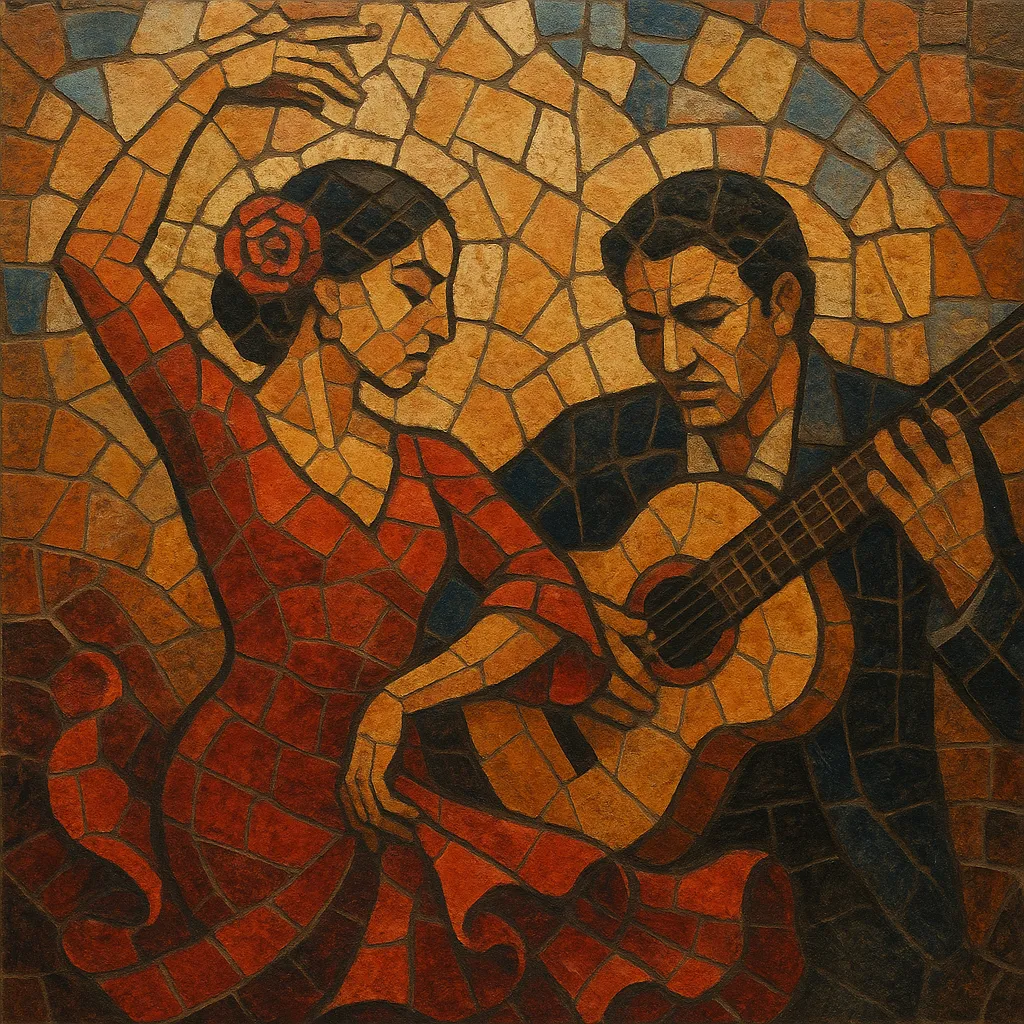Flamenco is a highly expressive musical and dance tradition from Andalusia that combines cante (song), toque (guitar), baile (dance), palmas (handclaps), and jaleo (shouts of encouragement).
It is characterized by intricate rhythmic cycles called compás, intense vocal melismas with ornamental micro-inflections, and guitar techniques such as rasgueado, picado, alzapúa, golpe, and tremolo.
Harmonically it often centers on the Phrygian mode and the Andalusian cadence (iv–III–II–I), creating a dramatic tension that complements the emotional depth of the lyrics, which frequently explore themes of love, loss, pride, and fate.
Flamenco is organized into palos (forms) such as soleá, bulería, alegrías, seguiriyas, tientos/tangos, fandangos, tarantas, and rumba, each defined by its compás, mood, and traditional melodic/harmonic vocabulary.
Flamenco coalesced in Andalusia in the late 18th to early 19th century, emerging from interactions among Romani (Gitano), Andalusian, Moorish/Andalusí, and Sephardic traditions. Early song practices (cante jondo) drew on deep, ornamental vocal styles, while Spanish folk dance-song forms like fandango and seguidilla, and theatrical tonadilla, provided structures and refrains. The Phrygian-inflected harmony and elaborate melismas reflect Iberian–Mediterranean syncretism.
From the mid‑1800s, cafés cantantes professionalized flamenco. Singers and guitarists such as Silverio Franconetti helped codify palos like soleá and seguiriyas. Guitar accompaniment became increasingly virtuosic, setting the stage for a modern concert idiom. By the late 19th century, forms like bulería and alegrías crystallized, and baile technique (including zapateado footwork) flourished.
Between the 1910s and 1950s, flamenco expanded to theaters and festivals (the so‑called Ópera flamenca period). While some folklorization occurred, master singers (e.g., La Niña de los Peines, Manuel Torre) and guitar innovators (Ramón Montoya, later Sabicas) refined the repertoire. Recording and radio disseminated the style beyond Spain.
From the 1960s–80s, artists such as Paco de Lucía and Camarón de la Isla modernized harmony, form, and ensemble practice, introducing the Peruvian cajón and engaging with jazz, Latin, and popular music. Manolo Sanlúcar, Enrique Morente, and Tomatito further expanded the harmonic palette and compositional ambition, paving the way for nuevo flamenco.
Since the 1990s, flamenco has become a global art music and dance form with strong conservatory and festival circuits. Crossovers spawned substyles like flamenco jazz, flamenco pop, and flamenco urbano. In 2010, UNESCO inscribed flamenco on the Representative List of the Intangible Cultural Heritage of Humanity. Today, tradition and innovation coexist, with artists honoring classic cante and compás while exploring new timbres and collaborations.
Internalize each palo’s compás using palmas and footwork. Examples:
•Soleá/alegrías: 12-beat cycle with accents commonly on 12, 3, 6, 8, 10.
•Bulería: 12-beat with fluid phrasing; typical accents on 12, 3, 6, 8, 10 (with syncopations and llamadas).
•Tangos/rumba: 4/4 groove with strong backbeat; tangos is earthier, rumba is lighter/dancing.
•Arrange llamadas (calls) and cierres (cadential closes) to cue sections for dance and cante.


